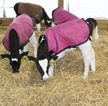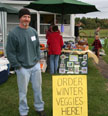
The February 9, 2018 edition of Bovine Veterinarian highlights the Northern New York Agricultural Development Program-funded Winter Calf Respiratory Health project led by NNY Regional Dairy Specialist Dr. Kimberley Morrill. Click here to see that story.
Click here to see the December 12, 2017 Spectrum News report by Katelynn Ulrich who visited Five Mile Farm in St. Lawrence County to talk with Kim and farmer Ryan Akins.
Click here to read the Northern New York Agricultural Development Program-funded project report on ways to enhance calf health through the cold winter months in Northern NY.


 On Saturday, March 24, Ivy will lead a “Growing Vegetables to Sell in Northern New York” workshop for those already commercially growing vegetables and those considering expanding their vegetable production to commercial scale. She will focus on growing vegetables in the spring and fall seasons in spite of the cold climate of Northern New York. The discussion will include using high and low tunnels and row covers.
On Saturday, March 24, Ivy will lead a “Growing Vegetables to Sell in Northern New York” workshop for those already commercially growing vegetables and those considering expanding their vegetable production to commercial scale. She will focus on growing vegetables in the spring and fall seasons in spite of the cold climate of Northern New York. The discussion will include using high and low tunnels and row covers. Northern N.Y. The farmer-driven Northern New York Agricultural Development Program has posted its annual report at
Northern N.Y. The farmer-driven Northern New York Agricultural Development Program has posted its annual report at  Cornell University Nutrient Management Program Director Dr. Quirine M. Ketterings is cited in the report crediting the farmers and farm advisers in Northern New York as “the frontrunners” prompting re-evaluation of the Cornell corn production guidelines. The farmers who prioritize and select projects for Northern New York Agricultural Development Program funding requested research into how advances in corn breeding and production practices are impacting crop yield and whether it was time to update the associated nitrogen application guidelines for agronomic and economic efficiency.
Cornell University Nutrient Management Program Director Dr. Quirine M. Ketterings is cited in the report crediting the farmers and farm advisers in Northern New York as “the frontrunners” prompting re-evaluation of the Cornell corn production guidelines. The farmers who prioritize and select projects for Northern New York Agricultural Development Program funding requested research into how advances in corn breeding and production practices are impacting crop yield and whether it was time to update the associated nitrogen application guidelines for agronomic and economic efficiency. A brief section in the report points to multi-state interest in the biocontrol crop pest solution built by the long-term commitment of the farmers of the Northern New York Agricultural Development Program to developing the science needed to manage the devastating alfalfa snout beetle.
A brief section in the report points to multi-state interest in the biocontrol crop pest solution built by the long-term commitment of the farmers of the Northern New York Agricultural Development Program to developing the science needed to manage the devastating alfalfa snout beetle.